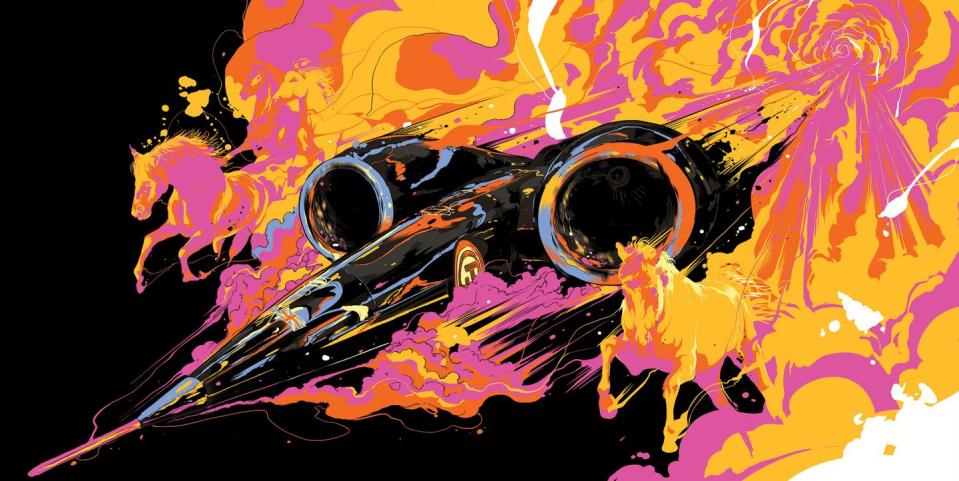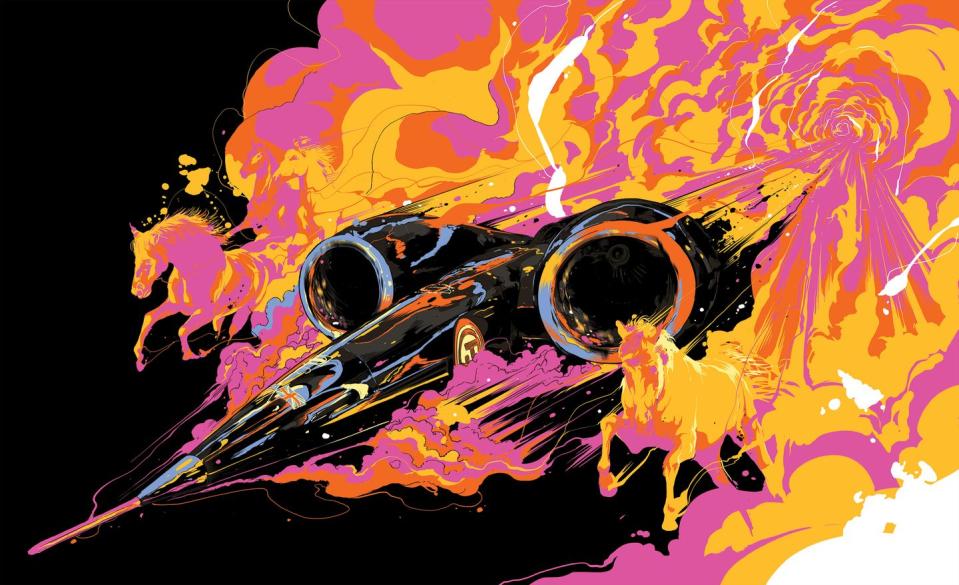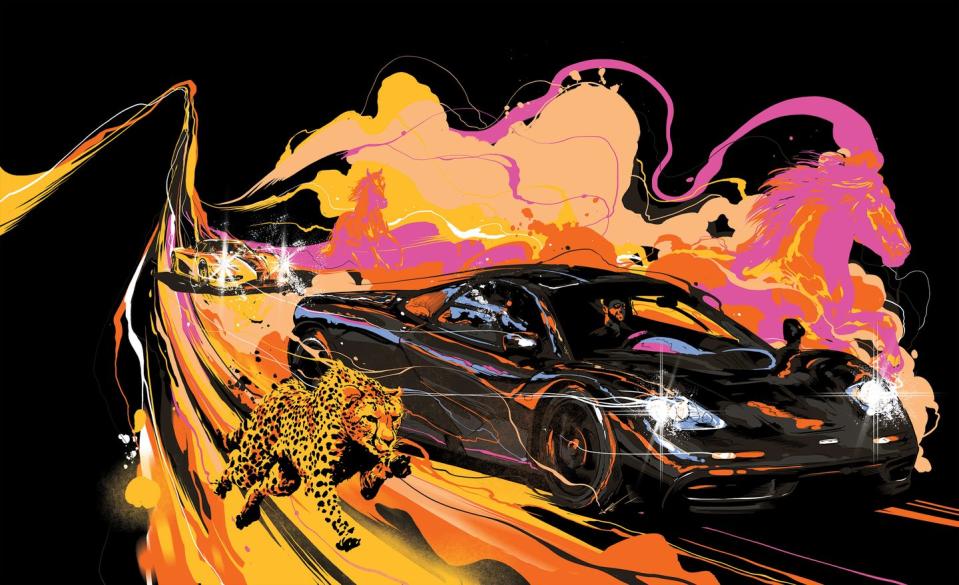A Requiem for Speed Records


The first recognized automotive speed record was set in 1898 by the French aristocrat Count Charles-François Gaston Louis Prosper de Chasseloup-Laubat. He entered an electric Jeantaud in a test organized by an early auto magazine and covered the flying kilometer in well under a minute. Like 57 seconds. Astounding. That’s 39.24 mph!
This story originally appeared in Volume 14 of Road & Track.
SIGN UP FOR THE TRACK CLUB BY R&T FOR MORE EXCLUSIVE STORIES
That was barely faster than a galloping horse and much slower than the speediest locomotives of the era. Yet the car would soon overwhelm the train. In 1904, an elegant 4-4-0 steamer belonging to England’s Great Western Railway became the first vehicle in the world to (disputably) break the 100-mph barrier, albeit briefly and on a falling gradient. Two months later, Louis Rigolly, another Frenchman, pushed the automotive record to 103.56 mph in a 13.5-liter Gobron-Brillié race car. From that point on, the land speed record has been held by loosely defined automobiles and the occasional rocket-propelled sled.
The bar soon jumped as increasingly powerful cars, and increasingly brave drivers, flung themselves at glory. Benchmarks fell quickly: 150 mph in 1925, 200 mph in 1927, and 300 mph in 1935, when Malcolm Campbell took his Blue Bird V, powered by a supercharged Rolls-Royce aero engine making a reputed 2300 hp, to the salt at Bonneville. But record setting also proved dangerous; onetime record holders J.G. Parry-Thomas, a Brit, in 1927 and Frank Lockhart, an American, in 1928 both died during failed attempts. Many other record setters were killed chasing ever further-out benchmarks before World War II.
Postwar, the jet age brought a new challenge: cars that exceeded what was possible with wheel-driven propulsion. But the French International Association of Recognized Automobile Clubs (AIACR), precursor to the FIA and arbiter of the record, insisted that vehicles setting the record be wheel driven. So when young Americans built jet-powered specials, they found themselves excluded from the “official” record. The generational clash was summed up when Craig Breedlove’s jet-propelled Spirit of America went 407.45 mph in 1963, but the official record skipped him and went to Donald Campbell’s wheel-driven gas-turbine Bluebird Proteus the following year, although it had “only” been timed at 403.10 mph. (Spirit was also a three-wheeler, and therefore not a car, contended the AIACR.)
Technology won, and the rules were straightened out as it became clear that wheel-powered cars couldn’t keep up with jets and rockets. A period of intense rivalry between the jet cars followed, as Breedlove’s Spirit and Art Arfons’s Green Monster traded times on the salt at Bonneville. No fewer than five new records were set during 1965 alone. The following year, Breedlove’s second Spirit, with a bigger engine and four wheels, moved the record past 600 mph. The figure seemed unbeatable until Gary Gabelich’s rocket-powered Blue Flame, surely the most beautiful record setter ever, managed 622.407 mph running on a cocktail of liquefied natural gas and high-test peroxide in 1970.
Half a century later, only two cars have gone faster. Teams led by Scotland’s Richard Noble created both. A record-obsessed adventurer, Noble produced his first challenger while still in his twenties. Thrust 1 (the juvenile name was part of the fun) combined a truck chassis with a military surplus jet engine. It was insane, and was written off when Noble crashed at 140 mph in 1977. He enlisted expert engineering help to create Thrust 2 and used his considerable charisma to raise the money to take it to Nevada’s Black Rock Desert in 1983. There he drove it to 633.468 mph, beating Gabelich’s record.
Success triggered more interest, and Breedlove promised to build a challenger. Noble responded in kind with the Thrust SSC—as in “supersonic car”—wisely giving up driving duties to active-duty Royal Air Force fighter pilot Andy Green. The aim was to break the sound barrier, which they achieved at Black Rock in October 1997, less than a month after setting the last slower-than-sound record. By traveling at 763.04 mph, Green became the fastest human to travel on the planet’s surface. More than 25 years later, he still is.

But the costs of building and running the Thrust SSC, even with a volunteer staff, had nearly been too much. The $160,000 fuel bill for the record attempts was only paid after the car had reached the desert. So when Noble announced plans for an even more ambitious project in 2008, built to break the 1000-mph barrier using both jet and rocket power, the obvious question was where the money would come from.
Bloodhound SSC engineered its new project to utilize both a Rolls-Royce EJ200 jet engine and a secondary rocket motor produced by the Norwegian company Nammo. The pair provided the extra thrust required to reach four-figure speeds, with mind-blowing solutions throughout; the original proposal was to use a Formula 1–spec Cosworth 2.4-liter V-8 just as a fuel pump for this motor. The project’s slipping timeframes soon showed how hard all of this rocket science was. In 2012, Noble said the project needed $28 million and would run on a dry lake bed in South Africa in 2014. By 2015, the planned trip to Africa had slipped to 2016, and the budget had increased to $61 million, with much of that unsecured.
Eventually, Bloodhound ran at low speed on an airport runway in the U.K. to raise interest. Behind the scenes, Noble also tried to put together a sponsorship deal with the Chinese Geely Group. But it didn’t succeed in time. In 2018, the project went bankrupt.
Yet the Bloodhound story doesn’t end there. Having rescued Bloodhound from the junkyard, the wealthy British industrialist Ian Warhurst was persuaded to buy the whole outfit and fund the long-delayed trip to South Africa, although one where the car would run only on jet power. He reportedly spent more than $1 million, with the Bloodhound managing an impressive 628 mph. But it didn’t raise enough commercial interest to fund a full attempt. “I might have proved I’m a bit mad by paying what I’ve paid for, but I’m not mad enough to carry on,” Warhurst said after he bowed out.
Bloodhound SSC is now parked at the Coventry Transport Museum alongside Thrust 2 and Thrust SSC. Its jet engine has been removed and sent back to Rolls-Royce. But hope of another rebirth hasn’t died. Stuart Edmondson, formerly Bloodhound’s head of engineering and another former RAF officer, has taken over as CEO and is committed to a new attempt based around a switch to synthetic fuel for the jet engine, with an electric motor serving as fuel pump.

 Yahoo Autos
Yahoo Autos 